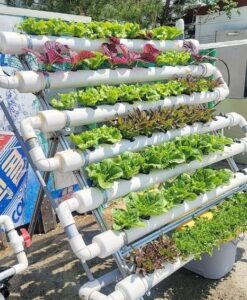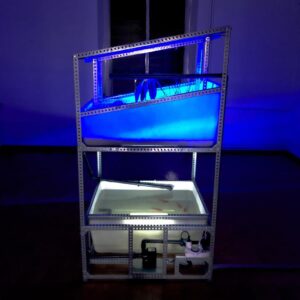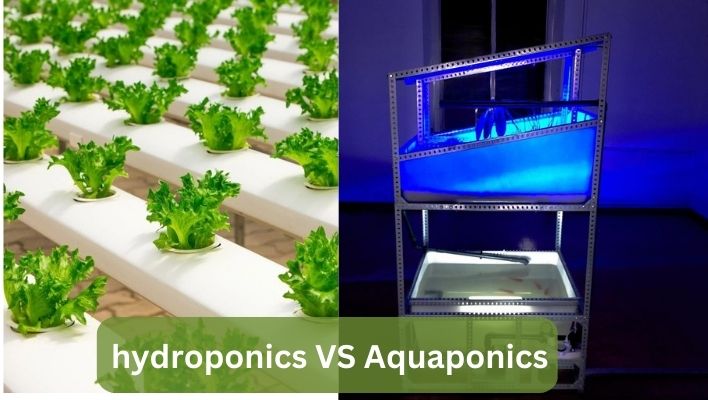Hydroponics and aquaponics are two popular methods of growing plants that are becoming increasingly popular among gardening enthusiasts and commercial growers.
Hydroponics is the practice of growing plants in water without soil, while aquaponics combines hydroponics with aquaculture, where fish are raised in the same water used to grow plants.
Both methods have gained popularity in recent years as a way to grow fresh produce in small spaces or areas where soil quality is poor. They offer unique advantages and disadvantages, making them suitable for different applications.
It’s important to understand the difference between hydroponics and aquaponics so that you can choose the method that best suits your needs.
In this article, we will explore the key differences between hydroponics and aquaponics and explain why it’s important to understand these differences for anyone interested in growing plants sustainably and efficiently.
What is Hydroponics?
Hydroponics is a method of growing plants without soil using a nutrient-rich water solution. Hydroponic systems typically involve a container filled with water and a growing medium, such as perlite or rockwool, where plants are anchored. The container’s pump circulates the water solution, delivering nutrients directly to the plant roots.
One advantage of hydroponics is that it allows precise control of the growing environment. By adjusting nutrient levels, pH, and water temperature, growers can optimize plant growth and maximize yields.
Hydroponics uses less water than traditional soil-based farming and can be done in small or indoor spaces. However, hydroponics has some disadvantages.
It can be more expensive to set up than traditional farming methods, and maintaining the water quality in the system requires careful monitoring. Additionally, hydroponic plants are vulnerable to power outages or equipment failures, which can be catastrophic for the crop.

Many types of plants can be grown using hydroponics, including leafy greens, herbs, and fruiting vegetables like tomatoes and peppers. However, some crops, such as root vegetables like carrots or potatoes, are more challenging to grow in hydroponic systems.
Hydroponic systems can be expensive to set up initially but may save money in the long run due to their efficiency and yield potential.
The cost will depend on the scale of the system and the specific equipment and materials used. Investigating ongoing maintenance costs, such as electricity and nutrient solutions, is important.
Overall, hydroponics is a promising method of growing crops with unique advantages and challenges. By understanding how hydroponic systems work and what plants best suit this method, growers can make informed decisions about incorporating hydroponics into their farming practices.
What is Aquaponics?
Aquaponics combines hydroponics and fish farming, where the waste produced by fish is used as a fertilizer for plants. In an aquaponic system, fish are raised in a tank or pond, and the water from the tank is circulated through a hydroponic system where plants are grown.
The plants absorb the nutrients from the fish waste, filtering the water, which is then returned to the fish tank. One of the most significant advantages of aquaponics is that it’s a closed-loop system, meaning that water and nutrients are recycled, reducing water usage and waste.
It’s also a highly efficient way of producing fish and vegetables. Some studies suggest aquaponics can produce up to 10 times more crops per square foot than traditional farming methods.

However, the aquaponics system also has some disadvantages. It can be more complex and difficult to set up and maintain than hydroponics or traditional farming methods.
Fish and plant health must be closely monitored, and balancing the nutrient levels in the system can be challenging. Additionally, the initial setup costs for an aquaponic system can be high, especially if a large-scale system is desired.
When it comes to fish, many different species can be used in aquaponic systems, including tilapia, trout, and catfish. The choice of fish will depend on factors such as water temperature and pH, as well as personal preference and local regulations.
Maintaining an aquaponic system requires regular attention to the health and well-being of both fish and plants. Good water quality and nutrient levels must be maintained, and any issues, such as disease outbreaks or equipment failures, must be addressed quickly to prevent losses.
Overall, aquaponics is a unique and promising method of sustainable food production. By understanding how aquaponic systems work and what fish and plants are best suited for this method, growers can make informed decisions about incorporating aquaponics into their farming practices.
Differences Between Hydroponics and Aquaponics

Hydroponics and aquaponics are both methods of growing plants without soil, but there are some key differences between the two systems:
| Hydroponics | Aquaponics |
|---|---|
| It uses a nutrient-rich water solution | Uses fish waste as a nutrient source |
| It does not involve raising fish | It involves raising fish as well as plants |
| Requires regular addition of nutrients | The fish waste provides nutrients |
| Easier to set up and maintain | More complex to set up and maintain |
| Lower initial investment costs | Higher initial investment costs |
| It can be done indoors or outdoors | Typically done indoors |
| Better for growing certain crops, such as leafy greens | Better for growing certain crops, such as herbs and fruiting vegetables |
| Water and nutrient levels can be precisely controlled | Requires careful monitoring of water quality and fish health |
| More susceptible to disease and pest outbreaks | They can be affected by disease and pest outbreaks but are generally less susceptible |
| This can result in higher yields and faster growth | May produce better-tasting and more nutritious crops |
| Higher water usage and waste production | Closed-loop system that recycles waste and reduces water usage |
| Requires regular nutrient additions and pH monitoring | Requires monitoring of water quality, fish health, and pH |
The advantages and disadvantages of each system will depend on the specific needs and goals of the grower. Hydroponics is generally easier to set up and maintain, making it a good option for beginners or those wanting to grow crops on a smaller scale.
However, aquaponics has the advantage of producing fish and plants in a closed-loop system, which can be more sustainable and efficient in the long run.
Regarding crop selection, hydroponics may be better suited for leafy greens or smaller plants, while aquaponics may be better for herbs and fruiting vegetables like tomatoes and peppers.
Additionally, aquaponics may have an advantage in taste and nutrition, as the plants can absorb more nutrients from fish waste than hydroponic nutrient solutions.
Ultimately, the choice between hydroponics and aquaponics will depend on factors such as space, budget, and the specific crops the grower wants to produce. By understanding the differences between the two systems, growers can make informed decisions about which method is best suited for their needs.
Advantages and disadvantages of each system
Hydroponics
Advantages of hydroponics:
- Precise control over water and nutrient levels can result in higher crop yields and faster growth.
- It can be done indoors or outdoors, making it a flexible option for growers.
- Easier to set up and maintain compared to aquaponics.
- Lower initial investment costs compared to aquaponics.
- It can be used to grow a wide variety of crops.
Disadvantages of hydroponics:
- Requires regular addition of nutrients to the water solution.
- They can be more susceptible to disease and pest outbreaks.
- It does not produce any additional benefits like aquaponics, such as raising fish.
Aquaponics
Advantages of aquaponics:
- Produces fish and plants in a closed-loop system, reducing waste and increasing sustainability.
- Fish waste provides a natural source of plant nutrients, reducing the need for regular nutrient additions.
- This can result in better-tasting and more nutritious crops.
- It can be used to grow a wide variety of crops.
- It can be a profitable business for growers.
Disadvantages of aquaponics:
- Requires careful monitoring of water quality and fish health.
- It can be more complex to set up and maintain compared to hydroponics.
- Higher initial investment costs compared to hydroponics.
- Typically done indoors, limiting the space available for growing.
- Fish and plant health must be closely monitored to prevent disease outbreaks and losses.
Can aquaponic systems be used for commercial purposes?
Yes, aquaponic systems can be used for commercial purposes. In fact, aquaponics has gained popularity in recent years as a sustainable and profitable method of agriculture.
Commercial aquaponic systems can range in size from small-scale operations to large commercial farms, depending on the specific needs and goals of the business.
Some commercial aquaponic farms specialize in growing high-value crops such as herbs, micro greens, or exotic vegetables, while others focus on fish production for food markets.
Aquaponics offers several advantages for commercial growers, including reduced water usage, efficient nutrient recycling, and increased crop yields.
Additionally, aquaponic systems can be operated year-round in a controlled environment, allowing for consistent crop production and predictable revenue streams.
While aquaponics can be profitable, it requires specialized knowledge and experience in aquaculture and hydroponics. Successful commercial aquaponic operations require careful planning, ongoing maintenance, and attention to detail to ensure optimal plant and fish health and profitability.

Which system is more sustainable?
Both aquaponic and hydroponic systems can be sustainable, but aquaponics has some advantages over hydroponics regarding sustainability.
In hydroponics, the plants are grown in a nutrient-rich water solution that needs replenishment with new nutrient solutions. The excess water is usually drained and recycled back into the system.
While hydroponics can be water-efficient compared to traditional soil-based agriculture, it can still be resource-intensive and require large amounts of energy and inputs such as fertilizers.
On the other hand, aquaponics combines hydroponics with aquaculture, which creates a closed-loop system that recycles water and nutrients. In an aquaponic system, the fish waste provides nutrients for the plants, while the plants help to filter and clean the water for the fish.
This means an aquaponic system can be more sustainable than hydroponics because it requires fewer inputs and can operate with little to no water waste.
Furthermore, aquaponics can be an eco-friendly way of producing food because it can reduce the need for chemical fertilizers and pesticides.
Fish waste in aquaponics can provide all the necessary nutrients for plant growth, and the plants can act as a natural filter to clean the water. This can result in healthier plants and fish and a more sustainable and environmentally friendly method of food production.
Hydroponics and Aquaponics FAQ:
Is one system better than the other?
This question has no clear answer, as both systems have advantages and disadvantages. Hydroponics can result in higher yields and faster growth, while aquaponics is generally more sustainable and environmentally friendly.
Hydroponics can be a better choice if you are looking for a system that is easy to set up, uses less space, and requires less maintenance.
On the other aquaponics may be a better option hand, aquaponics may be a better option if you want a more sustainable approach that recycles water and nutrients and produces both plants.
The choice between the two will depend on factors such as the grower’s goals, available resources, and level of expertise.
Can you grow the same plants in both systems?
Yes, you can grow the same plants in both systems. Plants grown in hydroponics or aquaponics can grow faster and yield more produce than traditional soil-based methods.
However, some plants may perform better in one plan than the other due to their specific nutrient, water requirements, or growing conditions.
Do you need special training to start a hydroponic or aquaponic system?
While you don’t necessarily need special training, learning the basics of hydroponics or aquaponics before starting a system can be helpful.
Many resources are available, including books, online courses, and workshops that can provide valuable information on system design, water quality, plant and fish care, and troubleshooting.
How much space do you need for a hydroponic or aquaponic system?
The amount of space needed for a hydroponic or aquaponic system depends on the type and size of the system, as well as the number and size of the plants and fish and the scale of the operation.
Hydroponic systems can be smaller and more compact, making them suitable for indoor and urban farming.
On the other hand, aquaponic systems require space for plants and fish and may be better suited for outdoor or larger-scale farming. However, many aquaponic and hydroponic systems can be designed to fit any space, from small apartments to commercial farms.
Conclusion
Hydroponics and aquaponics are two popular methods of growing plants and fish in controlled environments. Hydroponics involves growing plants in nutrient-rich water, while aquaponics combines fish farming with hydroponics to create a closed-loop system.
The key differences between these systems include the use of fish in aquaponics, the type of nutrients used, and the level of sustainability.
When deciding between hydroponics and aquaponics, you must consider your goals, available resources, and level of expertise. While both systems have advantages and disadvantages, choosing the right system for your needs can help you achieve your desired results.
With proper knowledge and planning, hydroponic and aquaponic systems can effectively grow plants and fish in a controlled environment.
